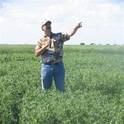
Novel management practices are needed to improve the declining dryland crop yields and soil organic matter contents using conventional farming practices in the northern Great Plains. We evaluated the 21-yr effect of tillage and cropping sequence on dryland grain and biomass (stems + leaves) yields of spring wheat (Triticum aestivum L.), barley (Hordeum vulgare L.), and pea (Pisum sativum L.) and soil organic matter at the 0- to 20-cm depth in eastern Montana, USA. Treatments were no-tilled continuous spring wheat (NTCW), spring-tilled continuous spring wheat (STCW), fall- and spring-tilled continuous spring wheat (FSTCW), fall- and spring-tilled spring wheat-barley (1984–1999) followed by spring wheat-pea (2000–2004) (FSTW-B/P), and the conventional spring-tilled spring wheat-fallow (STW-F). Spring wheat grain and biomass yields increased with crop growing season precipitation (GSP) and were greater in STW-F than in FSTCW and FSTW-B/P when GSP was <250 mm. Although mean grain and biomass yields were greater, annualized yields were lower in STW-F than in other treatments. In FSTW-B/P, barley and pea grain and biomass yields also increased with increased GSP. Soil organic C and total N were lower in STW-F than in other treatments and linearly related (R 2 = 0.64 to 0.78) with total annualized biomass residue returned to the soil from 1984 to 2004. Alternate-year summer fallowing increased spring wheat grain and biomass yields compared with annual cropping but reduced annualized yields and soil organic matter. For sustaining dryland crop yields and soil organic matter, no-tillage with annual cropping system can be adopted in the northern Great Plains.
Available at: http://works.bepress.com/andrew_lenssen/3/
